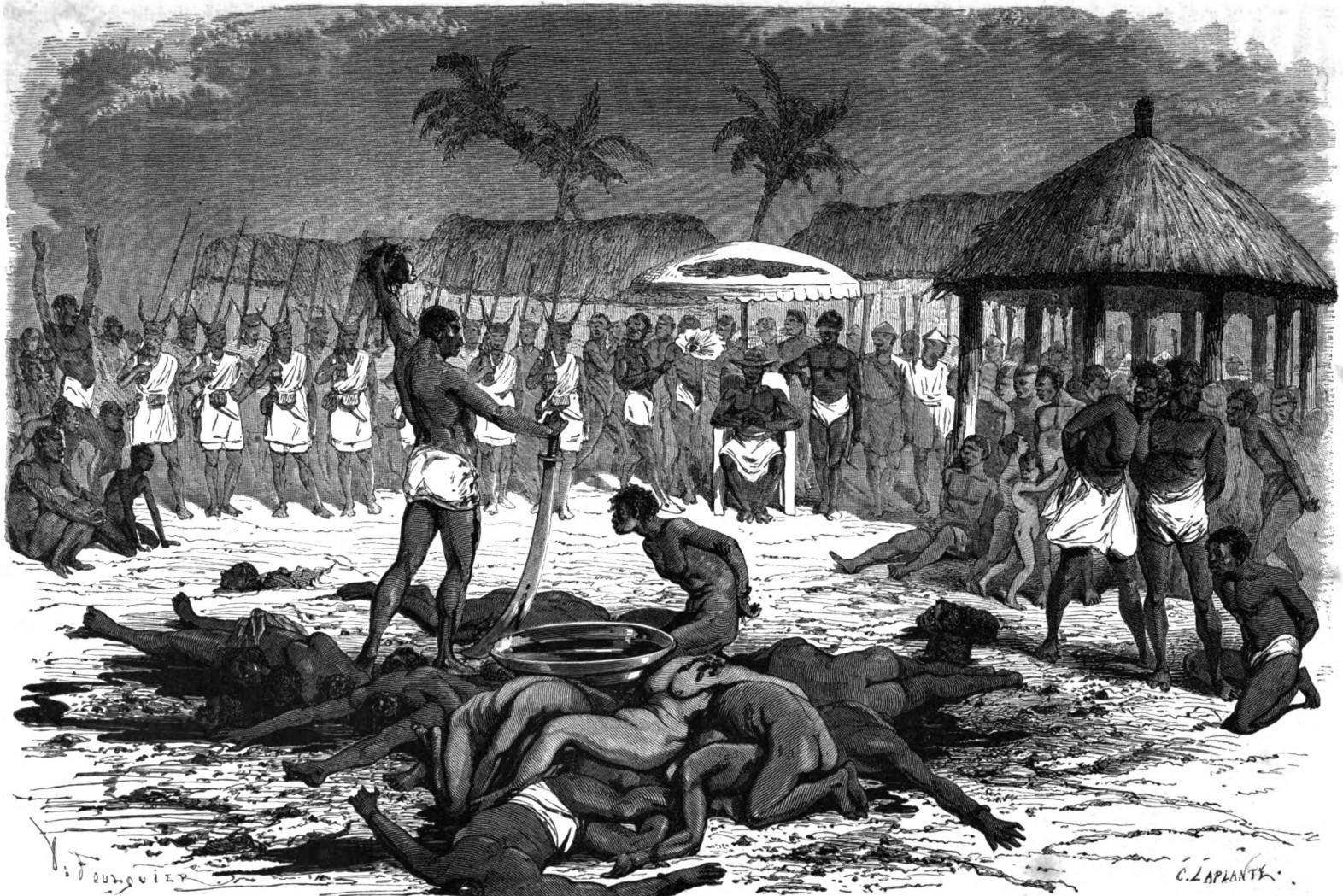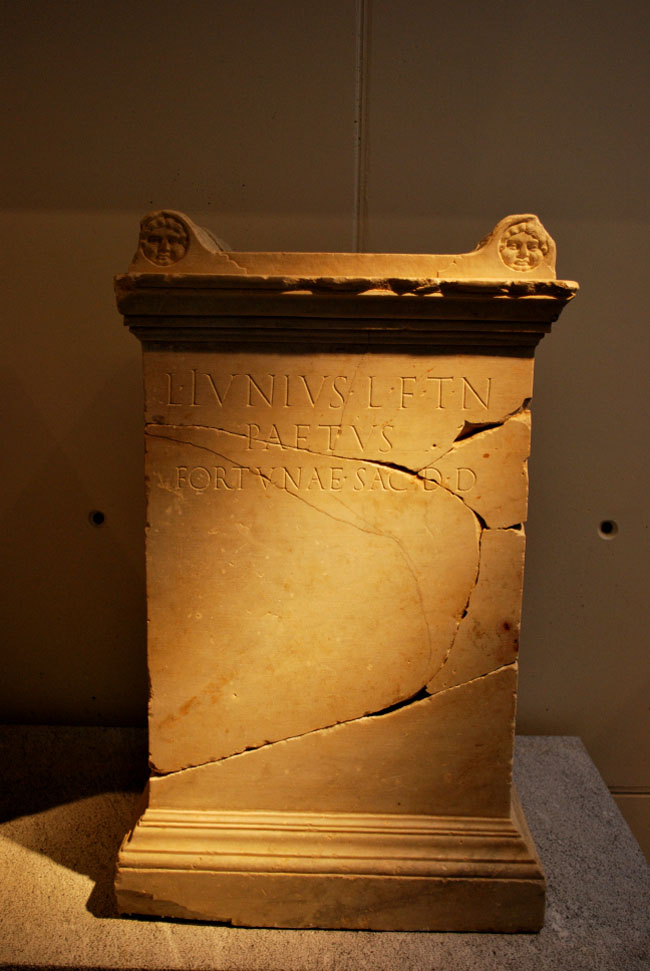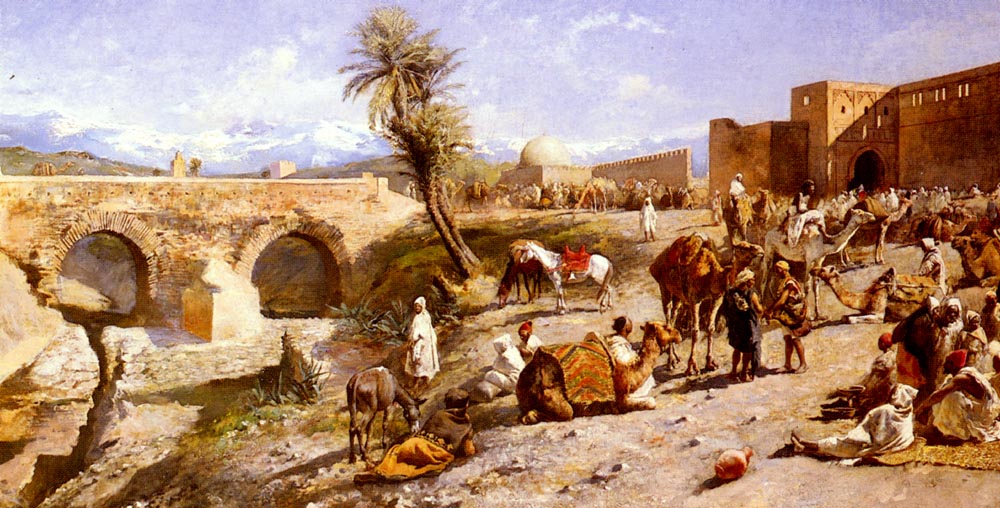|
Argei
The rituals of the Argei were archaic religious observances in ancient Rome that took place on March 16 and March 17, and again on May 14 or May 15. By the time of Augustus, the meaning of these rituals had become obscure even to those who practiced them. For the May rites, a procession of pontiffs, Vestals, and praetors made its way around a circuit of 27 stations ( ''sacella'' or ''sacraria''), where at each they retrieved a figure fashioned into human form from rush, reed, and straw, resembling men tied hand and foot. After all the stations were visited, the procession, accompanied by the Flaminica Dialis in mourning guise, moved to the Pons Sublicius, the oldest known bridge in Rome, where the gathered figures were tossed into the Tiber River. Both the figures (''effigies'' or '' simulacra'') and the stations or shrines were called ''Argei'', the etymology of which remains undetermined. The continuation of these rites into the later historical period when they were ... [...More Info...] [...Related Items...] OR: [Wikipedia] [Google] [Baidu] |
Pons Sublicius
The Pons Sublicius is the earliest known bridge of ancient Rome, spanning the Tiber River near the Forum Boarium ("cattle forum") downstream from the Tiber Island, near the foot of the Aventine Hill. According to tradition, its construction was ordered by Ancus Marcius around 642 BC, but this date is approximate because there is no ancient record of its construction. Marcius wished to connect the newly fortified Janiculum Hill on the Etruscan side to the rest of Rome, augmenting the ferry that was there. The bridge was part of public works projects that included building a port at Ostia, at the time the location of worked salt deposits. Construction Legend tells us that the bridge was made entirely of wood. The name comes from Latin ''pons, pontis'', "bridge", and the adjective ''sublicius'', "resting on pilings", from the stem of ''sublicae'', pilings. As a ''sublica'' was a pick, ''sublicae'' implies pointed sticks; that is, the bridge was supported by pilings driven into ... [...More Info...] [...Related Items...] OR: [Wikipedia] [Google] [Baidu] |
Sacellum
A ''sacellum'' is a small shrine in ancient Roman religious contexts. The word is a diminutive of ''sacrum'' (neuter of ''sacer'', "belonging to a god"). The numerous ''sacella'' of ancient Rome included both shrines maintained on private properties by families, and public ones. A ''sacellum'' might be square or round. Varro and Verrius Flaccus describe ''sacella'' in ways that at first seem contradictory, the former defining a ''sacellum'' in its entirety as equivalent to a ''cella'', which is specifically an enclosed space, and the latter insisting that a ''sacellum'' had no roof. "Enclosure", however, is the shared characteristic, roofed over or not. "The ''sacellum''", notes Jörg Rüpke, "was both less complex and less elaborately defined than a temple proper". The meaning can overlap with that of ''sacrarium'', a place where sacred objects ''(sacra)'' were stored or deposited for safekeeping. The ''sacella'' of the Argei, for instance, are also called ''sacraria''. In pr ... [...More Info...] [...Related Items...] OR: [Wikipedia] [Google] [Baidu] |
Human Sacrifice
Human sacrifice is the act of killing one or more humans as part of a ritual, which is usually intended to please or appease deity, gods, a human ruler, public or jurisdictional demands for justice by capital punishment, an authoritative/priestly figure, spirits of veneration of the dead, dead ancestors or as a retainer sacrifice, wherein a monarch's servants are killed in order for them to continue to serve their master in the next life. Closely related practices found in some tribe, tribal societies are human cannibalism, cannibalism and headhunting. Human sacrifice is also known as ritual murder. Human sacrifice was practiced in many human societies beginning in prehistoric times. By the Iron Age with the associated developments in religion (the Axial Age), human sacrifice was becoming less common throughout Africa, Europe, and Asia, and came to be looked down upon as barbarian, barbaric during classical antiquity. In the New World, Americas, however, human sacrifice cont ... [...More Info...] [...Related Items...] OR: [Wikipedia] [Google] [Baidu] |
Saturn (mythology)
Saturn ( ) was a god in Religion in ancient Rome, ancient Roman religion, and a character in Roman mythology. He was described as a god of time, generation, dissolution, abundance, wealth, agriculture, periodic renewal and liberation. Saturn's mythological reign was depicted as a Golden Age of abundance and peace. After the Roman conquest of Greece, he was conflated with the Greek Titan Cronus. Saturn's consort was his sister Ops, with whom he fathered Jupiter (mythology), Jupiter, Neptune (mythology), Neptune, Pluto (mythology), Pluto, Juno (mythology), Juno, Ceres (Roman mythology), Ceres and Vesta (mythology), Vesta. Saturn was especially celebrated during the festival of Saturnalia each December, perhaps the most famous of the Roman festivals, a time of feasting, role reversals, free speech, gift-giving and revelry. The Temple of Saturn in the Forum Romanum, Roman Forum housed the state treasury and archives (''aerarium'') of the Roman Republic and the early Roman Empire. The ... [...More Info...] [...Related Items...] OR: [Wikipedia] [Google] [Baidu] |
Vestal Virgin
In ancient Rome, the Vestal Virgins or Vestals (, singular ) were priestesses of Vesta, virgin goddess of Rome's sacred hearth and its flame. The Vestals were unlike any other public priesthood. They were chosen before puberty from several suitable candidates, freed from any legal ties and obligations to their birth family, and enrolled in Vesta's priestly college of six priestesses. They were supervised by a senior vestal but chosen and governed by Rome's leading male priest, the -- in the Imperial era, this meant the emperor. Vesta's acolytes vowed to serve her for at least thirty years, study and practise her rites in service of the Roman State, and maintain their chastity throughout. In addition to their obligations on behalf of Rome, Vestals had extraordinary rights and privileges, some of which were granted to no others, male or female. The Vestals took turns to supervise Vesta's sacred hearth so that at least one Vestal was stationed there at all times. Vestals who ... [...More Info...] [...Related Items...] OR: [Wikipedia] [Google] [Baidu] |
Glossary Of Ancient Roman Religion
The vocabulary of ancient Roman religion was highly specialized. Its study affords important information about the religion, traditions and beliefs of the ancient Romans. This legacy is conspicuous in European cultural history in its influence on later juridical and religious vocabulary in Europe, particularly of the Christian Church. This glossary provides explanations of concepts as they were expressed in Latin pertaining to Religion in ancient Rome, religious practices and beliefs, with links to articles on major topics such as priesthoods, forms of divination, and rituals. For theonyms, or the names and epithets of gods, see List of Roman deities. For public religious holidays, see Roman festivals. For temples see the List of Ancient Roman temples. Individual landmarks of religious Topography of ancient Rome, topography in ancient Rome are not included in this list; see Roman temple. __NOTOC__ Glossary A abominari The verb ''abominari'' ("to avert an omen", from ''ab-'', ... [...More Info...] [...Related Items...] OR: [Wikipedia] [Google] [Baidu] |
Flamen Dialis
In ancient Roman religion, the was the high priest of Jupiter. The term ''Dialis'' is related to ''Diespiter'', an Old Latin form of the name ''Jupiter''. There were 15 '' flamines'', of whom three were ''flamines maiores'', serving the three gods of the Archaic Triad. According to tradition the ''flamines'' were forbidden to touch metal, ride a horse, or see a corpse. The ''Flamen Dialis'' was officially ranked second in the ranking of the highest Roman priests (''ordo sacerdotum''), behind only the '' rex sacrorum'' and before other '' flamines maiores'' ('' Flamen Martialis'', '' Flamen Quirinalis'') and '' pontifex maximus''. The office of Flamen Dialis, and the offices of the other ''flamines maiores'', were traditionally said to have been created by Numa Pompilius, second king of Rome, although Numa himself performed many of the rites of the Flamen Dialis. Appointment and privileges The Flamen Dialis enjoyed many peculiar honours. When a vacancy occurred, three pers ... [...More Info...] [...Related Items...] OR: [Wikipedia] [Google] [Baidu] |
Procession
A procession is an organized body of people walking in a formal or ceremonial manner. History Processions have in all peoples and at all times been a natural form of public celebration, as forming an orderly and impressive ceremony. Religious and triumphal processions are abundantly illustrated by ancient monuments, e.g. the religious processions of Egypt, those illustrated by the rock-carvings of Boghaz-Keui, the many representations of processions in Greek art, culminating in the great Panathenaic procession of the Parthenon Frieze, and Roman triumphal reliefs, such as those of the arch of Titus. Greco-Roman practice Processions played a prominent part in the great festivals of Greece, where they were always religious in character. The games were either opened or accompanied by more or less elaborate processions and sacrifices, while processions from the earliest times formed part of the worship of the old nature gods, as those connected with the cult of Dionysus and the P ... [...More Info...] [...Related Items...] OR: [Wikipedia] [Google] [Baidu] |
Ovid
Publius Ovidius Naso (; 20 March 43 BC – AD 17/18), known in English as Ovid ( ), was a Augustan literature (ancient Rome), Roman poet who lived during the reign of Augustus. He was a younger contemporary of Virgil and Horace, with whom he is often ranked as one of the three Western canon, canonical poets of Latin literature. The Roman Empire, Imperial scholar Quintilian considered him the last of the Latin love elegy, elegists.Quint. ''Inst.'' 10.1.93 Although Ovid enjoyed enormous popularity during his lifetime, the emperor Augustus Exile of Ovid, exiled him to Constanța, Tomis, the capital of the newly-organised province of Moesia, on the Black Sea, where he remained for the last nine or ten years of his life. Ovid himself attributed his banishment to a "poem and a mistake", but his reluctance to disclose specifics has resulted in much speculation among scholars. Ovid is most famous for the ''Metamorphoses'', a continuous mythological narrative in fifteen books written in ... [...More Info...] [...Related Items...] OR: [Wikipedia] [Google] [Baidu] |
Jupiter (mythology)
Jupiter ( or , from Proto-Italic language, Proto-Italic "day, sky" + "father", thus "sky father" Greek: Zeus, Δίας or Zeus, Ζεύς), also known as Jove (nominative case, nom. and genitive case, gen. ), is the sky god, god of the sky and god of thunder, thunder, and king of the gods in ancient Roman religion and Roman mythology, mythology. Jupiter was the chief deity of Roman state religion throughout the Roman Republic, Republican and Roman Empire, Imperial eras, until Constantine the Great and Christianity, Christianity became the dominant religion of the Empire. In Roman mythology, he negotiates with Numa Pompilius, the second king of Rome, to establish principles of Roman religion such as offering, or sacrifice. Jupiter is thought to have originated as a sky god. His identifying implement is the thunderbolt and his primary sacred animal is the eagle, which held precedence over other birds in the taking of auspices and became one of the most common symbols of the Roma ... [...More Info...] [...Related Items...] OR: [Wikipedia] [Google] [Baidu] |
Oracle
An oracle is a person or thing considered to provide insight, wise counsel or prophetic predictions, most notably including precognition of the future, inspired by deities. If done through occultic means, it is a form of divination. Description The word ''oracle'' comes from the Latin verb ''ōrāre'', "to speak" and properly refers to the priest or priestess uttering the prediction. In extended use, ''oracle'' may also refer to the ''site of the oracle'', and the oracular utterances themselves, are called ''khrēsmoí'' (χρησμοί) in Greek. Oracles were thought to be portals through which the gods spoke directly to people. In this sense, they were different from seers (''manteis'', μάντεις) who interpreted signs sent by the gods through bird signs, animal entrails, and other various methods.Flower, Michael Attyah. ''The Seer in Ancient Greece.'' Berkeley: University of California Press, 2008. The most important oracles of Greek antiquity were Pythia (priestes ... [...More Info...] [...Related Items...] OR: [Wikipedia] [Google] [Baidu] |
Religion In Ancient Rome
Religion in ancient Rome consisted of varying imperial and provincial religious practices, which were followed both by the Roman people, people of Rome as well as those who were brought under its rule. The Romans thought of themselves as highly religious, and attributed their success as a world power to their collective piety () in maintaining Pax deorum, good relations with the gods. Their Polytheism, polytheistic religion is known for having honoured List of Roman deities, many deities. The presence of Magna Graecia, Greeks on the Italian peninsula from the beginning of the historical period influenced Culture of ancient Rome, Roman culture, introducing some religious practices that became fundamental, such as the of Apollo. The Romans looked for common ground between their major gods and those of the Greeks (), adapting Greek mythology, Greek myths and iconography for Latin literature and Roman art, as the Etruscans had. Etruscan religion was also a major influence, partic ... [...More Info...] [...Related Items...] OR: [Wikipedia] [Google] [Baidu] |







